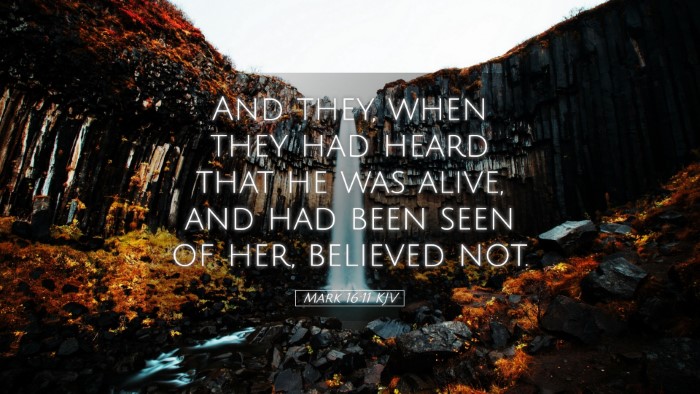Old Testament
Genesis Exodus Leviticus Numbers Deuteronomy Joshua Judges Ruth 1 Samuel 2 Samuel 1 Kings 2 Kings 1 Chronicles 2 Chronicles Ezra Nehemiah Esther Job Psalms Proverbs Ecclesiastes Song of Solomon Isaiah Jeremiah Lamentations Ezekiel Daniel Hosea Joel Amos Obadiah Jonah Micah Nahum Habakkuk Zephaniah Haggai Zechariah MalachiMark 16:11
Mark 16:11 KJV
And they, when they had heard that he was alive, and had been seen of her, believed not.
Mark 16:11 Bible Commentary
Commentary on Mark 16:11
Verse Reference: Mark 16:11 - "And they, when they had heard that he was alive, and had been seen of her, believed not."
Introduction
This verse serves a significant role in the resurrection narrative, illustrating both the disbelief of the disciples and the profound nature of Christ's resurrection. Commentaries by Matthew Henry, Albert Barnes, and Adam Clarke provide valuable insights into the theological implications and the historical context of this event.
The Disciples’ Unbelief
The response of the disciples to the report of Jesus’ resurrection is one of skepticism, highlighting a recurring theme of disbelief in the Gospels.
- Matthew Henry: Henry points out that the reaction of the disciples is not one of immediate faith, but rather confusion and doubt. He emphasizes that their unwillingness to accept the word of Mary Magdalene reflects a broader human disposition towards skepticism concerning divine matters.
- Albert Barnes: Barnes asserts that the disciples' disbelief underscores the credibility of the resurrection claims. He notes that their initial reaction was not only of doubt but also foreshadowed the eventual transformation of their faith after personal encounters with the risen Christ.
- Adam Clarke: Clarke elaborates on the nature of their unbelief, suggesting that it stemmed from a combination of fear, grief, and disbelief in the resurrection itself. He argues that their naturalistic worldview impeded their acceptance of the miraculous.
The Role of Women in the Resurrection Narrative
The account highlights Mary Magdalene's pivotal role as the first witness to the resurrection. This choice has significant implications within both the historical and theological frameworks.
- Henry: Comments on the important position of women in early Christianity, particularly noting that Mary’s encounter with the risen Lord reflects God’s plan to elevate women in the kingdom.
- Barnes: Emphasizes that the decision to reveal the resurrection to a woman first serves to validate the testimony of women, who had often been marginalized in society. This speaks to the radical nature of Christ's ministry.
- Clarke: Discusses the implications of Mary’s witness, arguing that her role is critical in recognizing the transformation from despair to hope and emphasizes the authenticity of the resurrection account.
Theological Implications
The disbelief captured in this verse raises important theological questions regarding faith, witness, and the nature of resurrection.
- Skepticism and Faith: Both Henry and Barnes highlight how the disciples' skepticism sets the stage for a deeper exploration of faith. Clarke reinforces the notion that true belief often emerges from a journey marked by doubts and questions.
- The Nature of Resurrection: The reluctance of the disciples to believe connects to a greater mystery of resurrection. Henry notes that resurrection challenges human understanding, signifying that faith often requires us to transcend our preconceptions.
- Witness and Testimony: The emphasis on testimony, particularly from those like Mary, points to the foundational role of witnesses in the early Church. Barnes remarks that the testimony of women is significant, laying the groundwork for the Gospel message to spread beyond cultural constraints.
Conclusion
Mark 16:11 reflects the complexity of human response to divine revelation. The initial disbelief of the disciples emphasizes their humanity, yet also sets the stage for their eventual transformation. Through the lens of public domain commentaries, we see a convergence of theological insight, historical context, and practical application that continues to resonate for pastors, students, and scholars today.


